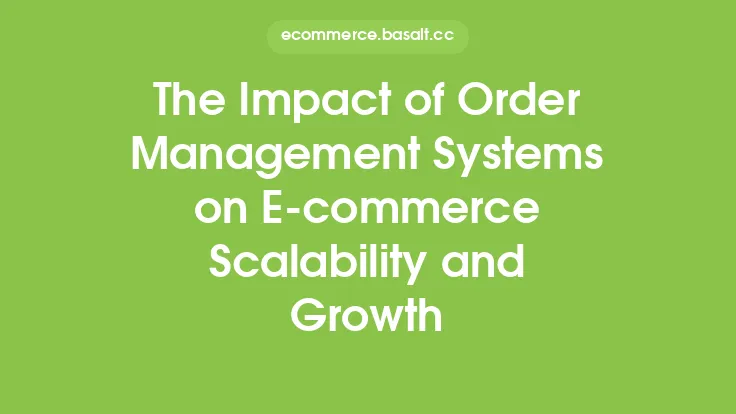In today's fast-paced e-commerce landscape, customer satisfaction is the key to driving business growth and loyalty. One crucial aspect of achieving high customer satisfaction is the effective management of orders. This is where order management systems (OMS) come into play, serving as the backbone of e-commerce operations by streamlining and automating the order fulfillment process. By leveraging an OMS, businesses can ensure timely and accurate delivery of products, which in turn, enhances the overall customer experience.
Introduction to Order Management Systems
An order management system is a software solution designed to manage and track orders from inception to delivery. It integrates with various e-commerce platforms, marketplaces, and other systems to provide a centralized view of all orders. This enables businesses to efficiently process, fulfill, and ship orders, reducing errors and delays. A well-implemented OMS can help e-commerce companies to improve their operational efficiency, reduce costs, and enhance customer satisfaction.
The Impact of Order Management on Customer Satisfaction
Customer satisfaction is closely tied to the order fulfillment process. When orders are fulfilled accurately and on time, customers are more likely to be satisfied with their purchase experience. An OMS plays a vital role in ensuring that orders are processed correctly and shipped promptly. By automating tasks such as order tracking, inventory management, and shipping, an OMS helps to minimize errors and delays, which can lead to disappointed customers. Furthermore, an OMS can provide customers with real-time updates on their order status, keeping them informed and engaged throughout the fulfillment process.
Key Components of an Order Management System
A comprehensive OMS typically consists of several key components, including order processing, inventory management, shipping and fulfillment, and returns management. The order processing component handles tasks such as order receipt, validation, and routing. Inventory management ensures that products are available and allocated correctly to fulfill orders. Shipping and fulfillment manage the physical delivery of products to customers, while returns management handles product returns and refunds. By integrating these components, an OMS provides a seamless and efficient order fulfillment process.
Benefits of Implementing an Order Management System
The benefits of implementing an OMS are numerous. Firstly, it improves order accuracy and reduces errors, which can lead to increased customer satisfaction. Secondly, it streamlines the order fulfillment process, enabling businesses to process orders more quickly and efficiently. This, in turn, can lead to faster shipping times and lower shipping costs. Additionally, an OMS provides real-time visibility into order status and inventory levels, enabling businesses to make informed decisions and respond quickly to changes in demand.
Best Practices for Using an Order Management System
To get the most out of an OMS, businesses should follow best practices such as integrating the system with other e-commerce platforms and marketplaces, configuring the system to meet specific business needs, and providing ongoing training and support to users. Regularly reviewing and analyzing order fulfillment data can also help businesses to identify areas for improvement and optimize their OMS configuration. By following these best practices, businesses can maximize the benefits of their OMS and improve customer satisfaction.
Measuring the Effectiveness of an Order Management System
To measure the effectiveness of an OMS, businesses should track key performance indicators (KPIs) such as order fulfillment rates, shipping times, and customer satisfaction ratings. By monitoring these KPIs, businesses can identify areas for improvement and make adjustments to their OMS configuration as needed. Additionally, businesses should regularly review and analyze order fulfillment data to identify trends and patterns, and make informed decisions about their e-commerce operations.
Future of Order Management Systems
The future of OMS is closely tied to the evolution of e-commerce and the increasing demand for fast, flexible, and personalized shopping experiences. As e-commerce continues to grow and become more complex, OMS will play an increasingly important role in enabling businesses to manage their orders efficiently and effectively. Emerging trends such as artificial intelligence, machine learning, and the Internet of Things (IoT) are expected to further enhance the capabilities of OMS, enabling businesses to provide even more seamless and personalized shopping experiences for their customers.
Conclusion
In conclusion, order management systems play a vital role in improving customer satisfaction in e-commerce. By streamlining and automating the order fulfillment process, an OMS can help businesses to improve order accuracy, reduce errors, and enhance the overall customer experience. As e-commerce continues to evolve, the importance of OMS will only continue to grow, and businesses that invest in these systems will be well-positioned to drive growth, loyalty, and customer satisfaction.





